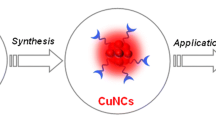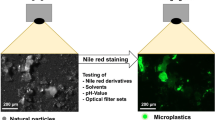Abstract
2,4,6-Trinitrophenol (TNP) is widely used in our daily life; however, excessive use of TNP can lead to a large number of diseases. Therefore, it is necessary to find an effective method to detect TNP. Herein, the rapid fluorescence quenching by TNP was developed for the fluorometric determination of TNP in aqueous medium based on the internal filter effect. Nitrogen-sulfur–codoped carbon nanoparticles (N,S-CNPs), synthesized by a one-pot solvothermal method with the precursors of l-cysteine and citric acid, were applied for the determination of TNP as a fluorescent probe. The excitation peak center of N,S-CNPs and the emission peak center are 340 nm and 423 nm, respectively. The probe can be used in a variety of conditions to detect TNP due to its relatively stable properties. Meanwhile, it has a fast response time (< 1 min), wide linear response range (0.1–40 μM), and low detection limit (43.0 nM). This probe still has excellent selectivity and high sensitivity. The method was also used to detect standard water samples with a satisfactory recovery rate, and it will be used in the application of pollutants and clinical diseases.

Graphical abstract






Similar content being viewed by others
References
Germain M, Knapp M. Optical explosives detection: from color changes to fluorescence turn-on. Chem Soc Rev. 2009;38:2543–55.
Salinas Y, Martinez-Manez R, Marcos M, Sancenon F, Costero A, Parra M, et al. Optical chemosensors and reagents to detect explosives. Chem Soc Rev. 2012;41:1261–96.
Pramanik S, Zheng C, Zhang X, Emge T, Li J. New microporous metal-organic framework demonstrating unique selectivity for detection of high explosives and aromatic compounds. J Am Chem Soc. 2011;133:4153–5.
Liu B. Metal-organic framework-based devices: separation and sensors. J Mater Chem. 2012;22:10094–101.
Hu Z, Deibert B, Li J. Luminescent metal–organic frameworks for chemical sensing and explosive detection. Chem Soc Rev. 2014;43:5815–40.
Hao Z, Song X, Zhu M, Meng X, Zhao S, Su S, et al. One-dimensional channel-structured Eu-MOF for sensing small organic molecules and Cu2+ ionuantum dots and their applications. J Mater Chem A. 2013;1:11043–50.
Chowdhury A, Mukherjee P. Electron-rich triphenylamine-based sensors for picric acid detection. J Org Chem. 2015;80:4064–75.
Nagarkar S, Desai A, Samanta P, Ghosh S. Aqueous phase selective detection of 2,4,6-trinitrophenol using a fluorescent metal–organic framework with a pendant recognition site. Dalton Trans. 2015;44:15175–80.
Vij V, Bhalla V, Kumar M. Attogram detection of picric acid by hexa-peri-hexabenzocoronene-based chemosensors by controlled aggregation-induced emission enhancement. ACS Appl Mater Interfaces. 2013;5:5373–80.
Krausa M, Schorb K. Trace detection of 2,4,6-trinitrotoluene in the gaseous phase by cyclic voltammetry. J Electroanal Chem. 1999;461:10–3.
Hakansson K, Coorey R, Zubarev R, Talrose V, Hakansson P. Low-mass ions observed in plasma desorption mass spectrometry of high explosives. J Mass Spectrom. 2000;35:337–46.
Sylvia J, Janni J, Klein J, Spencer K. Surface-enhanced raman detection of 2,4-dinitrotoluene impurity vapor as a marker to locate landmines. Anal Chem. 2000;72:5834–40.
Fang Y, Guo S, Li D, Zhu C, Ren W, Dong S, Wang E. Easy synthesis and imaging applications of cross-linked green fluorescent hollow carbon nanoparticles. ACS Nano. 2012;6:400–9.
Ali H, Bhunia S, Dalal C, Jana N. Red fluorescent carbon nanoparticle-based cell imaging probe. ACS Appl Mater & Interfaces. 2016;8:9305–13.
Wang W, Lu Y, Huang H, Wang A, Chen J, Feng J. Solvent-free synthesis of sulfur- and nitrogen-co-doped fluorescent carbon nanoparticles from glutathione for highly selective and sensitive detection of mercury(II) ions. Sensor and Actuat B: Chem. 2014;202:741–7.
Guo J, Lin Y, Huang H, Huang T, Zhang S, Weng W. One-pot fabrication of fluorescent carbon nitride nanoparticles with high crystallinity as a highly selective and sensitive sensor for free chlorine. Sensor and Actuat B: Chem. 2017;244:965–71.
Song Y, Zhu S, Zhang S, Fu Y, Wang L, Zhao X, et al. Investigation from chemical structure to photoluminescent mechanism: a type of carbon dots from the pyrolysis of citric acid and an amine. J Mater Chem C. 2015;3:5976–84.
Anilkumar P, Wang X, Cao L, Sahu S, Liu J, Wang P, et al. Toward quantitatively fluorescent carbon-based “quantum” dots. Nanoscale. 2011;3:2023–7.
Huang S, Qiu H, Zhu F, Lu S, Xiao Q. Graphene quantum dots as on-off-on fluorescent probes for chromium(VI) and ascorbic acid. Microchim Acta. 2015;182:1723–31.
Chen B, Chai S, Liu J, Liu C, Li Y, He J, et al. 2,4,6-Trinitrophenol detection by a new portable sensing gadget using carbon dots as a fluorescent probe. Anal Bioanal Chem. 2019;411:2291–300.
Meng Y, Jiao Y, Zhang Y, Li Y, Gao Y, Lu W, et al. Multi-sensing function integrated nitrogen-doped fluorescent carbon dots as the platform toward multi-mode detection and bioimaging. Talanta. 2020;210:120653.
Lin L, Rong M, Lu S, Song X, Zhang Y, Yan J, et al. A facile synthesis of highly luminescent nitrogen-doped graphene quantum dots for the detection of 2,4,6-trinitrophenol in aqueous solution. Nanoscale. 2015;7:1872–8.
Ma Y, Li H, Peng S, Wang L. Highly selective and sensitive fluorescent paper sensor for nitroaromatic explosive detection. Anal Chem. 2012;84:8415–21.
Wang Y, Ni Y. Molybdenum disulfide quantum dots as a photoluminescence sensing platform for 2,4,6-trinitrophenol detection. Anal Chem. 2014;86:7463–70.
Chen B, Liu Z, Zou H, Huang C. Highly selective detection of 2,4,6-trinitrophenol by using newly developed terbium-doped blue carbon dots. Analyst. 2016;141:2676–81.
Chen H, Ruan L, Jiang X, Qui L. Trace detection of nitro aromatic explosives by highly fluorescent g-C3N4 nanosheets. Analyst. 2015;140:637–43.
Dinda D, Gupta A, Shaw B, Sadhu S, Saha S. Highly selective detection of trinitrophenol by luminescent functionalized reduced graphene oxide through FRET mechanism. ACS Appl Mater Interfaces. 2014;6:10722–8.
Funding
This study was supported by the National Science Foundation of Fujian Province (Nos. 2016Y0065, 2018H0030, and 2018J05022), the Outstanding Youth Science Foundation of Fujian Province (Year 2017), the Education-Science Research Project for Young and Middle-aged Teachers of Fujian (No. JAT160295), the Program for Excellent Talents of Minnan Normal University (Grant No. MJ1601), and the Education Bureau of Fujian Province of China (No. JZ160453).
Author information
Authors and Affiliations
Corresponding authors
Ethics declarations
Conflict of interest
The authors declare that they have no conflict of interest.
Additional information
Publisher’s note
Springer Nature remains neutral with regard to jurisdictional claims in published maps and institutional affiliations.
Electronic supplementary material
ESM 1
(PDF 264 kb)
Rights and permissions
About this article
Cite this article
Lai, W., Guo, J., Zheng, N. et al. Selective determination of 2,4,6-trinitrophenol by using a novel carbon nanoparticles as a fluorescent probe in real sample. Anal Bioanal Chem 412, 3083–3090 (2020). https://doi.org/10.1007/s00216-020-02558-z
Received:
Revised:
Accepted:
Published:
Issue Date:
DOI: https://doi.org/10.1007/s00216-020-02558-z




